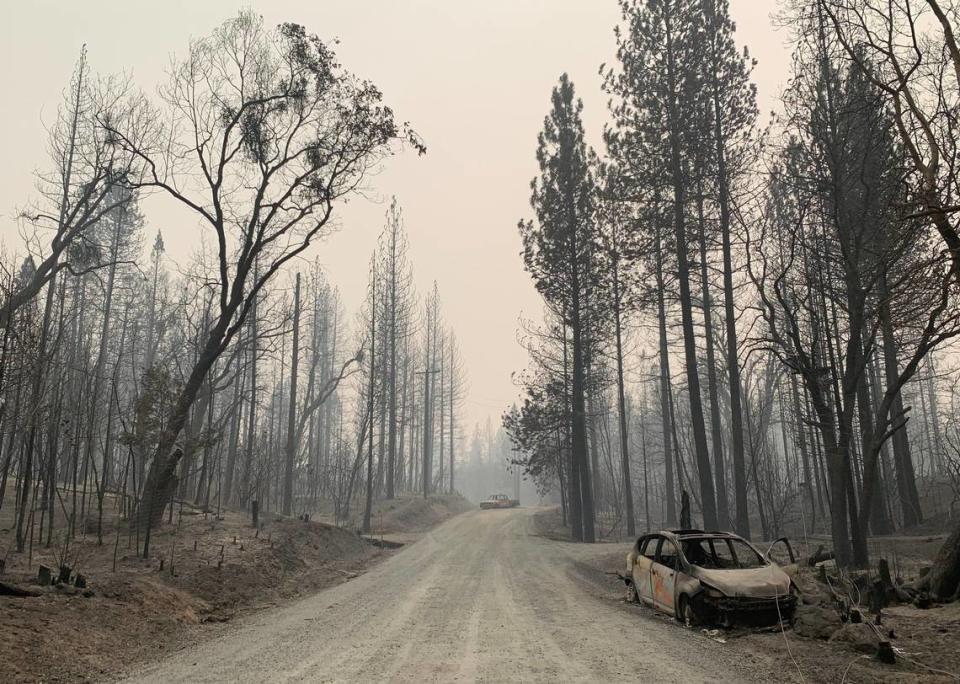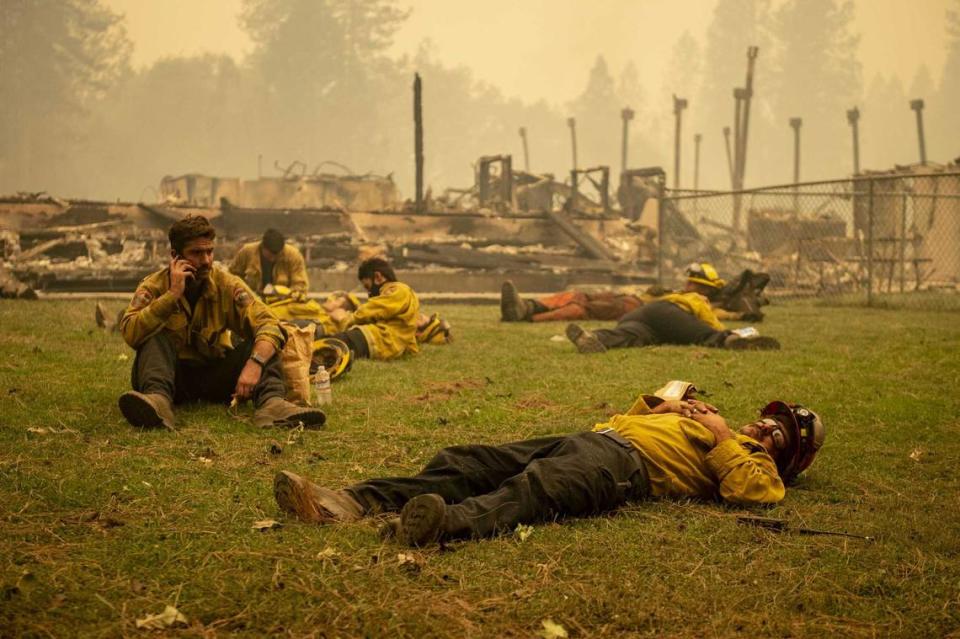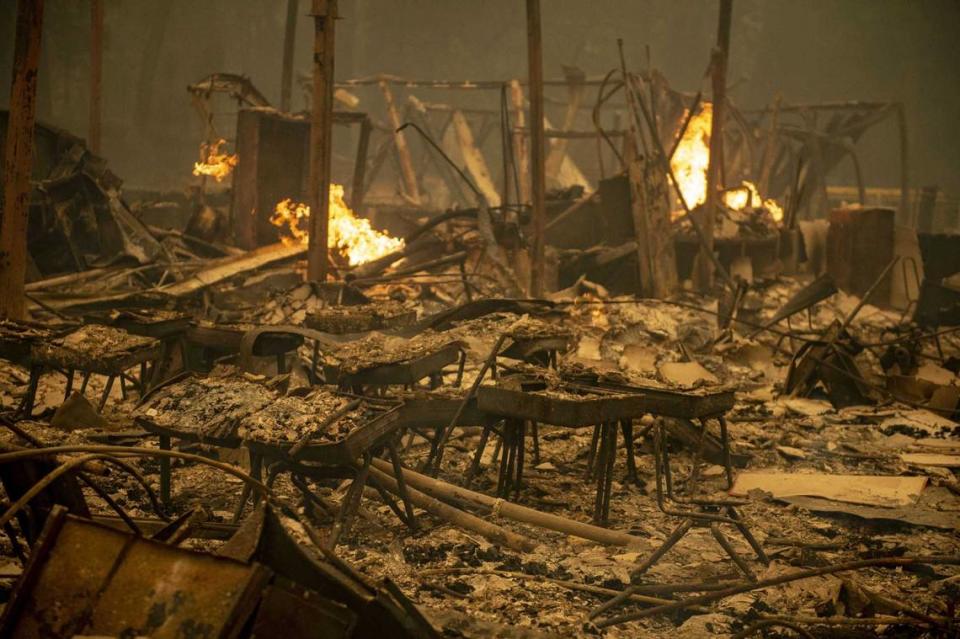‘Unstoppable.’ How the Bear Fire erupted into a deadly disaster for tiny Berry Creek
The Bear Fire looked like it would behave itself.
It had been burning for three weeks in the Plumas National Forest, the result of a mid-August lightning strike, but hadn’t done any lethal damage. It was part of a complex of fires that was about 50% contained. Even a significant windstorm that threatened to push the fire across the the middle fork of the Feather River didn’t seem like a major cause for alarm.
All told, in the early morning hours of Sept. 8, the team managing the Bear Fire appeared confident it could keep the fire under control. A team of firefighters on loan from Quebec was assigned to watch a potential trouble spot on the Feather River where the fire might jump.
Nonetheless, “we don’t see the huge potential for it to come out of there today,” said Jake Cagle, operations section chief with the California Interagency Incident Management Team, in a morning briefing posted to Facebook.
More than 30 miles to the southwest, in the tiny Butte County foothills community of Berry Creek, folks read news reports on the Bear Fire but they, too, weren’t overly concerned. No strangers to wildfire risk — it goes with the territory when you live just a few miles from Paradise, home to the deadliest California wildfire ever — they were certain the fire was simply too far away to pose a serious threat.
“We all thought we were OK,” said Berry Creek resident Bobbie Zedaker. “It didn’t seem like it was going to come toward us.”
Within hours, the Bear Fire became a monster.
Fueled by 45 mph winds, it jumped the Feather River with a ferocity that exceeded firefighters’ expectations and their ability to stop it. That night, it obliterated most of Berry Creek, a few miles north of Lake Oroville, leveling house after house and killing at least 15 people. Zedaker lost her home on Hidden Springs Road and her 16-year-old nephew, Josiah Williams. The fire is the fifth deadliest in California history, and the most lethal since the 2018 Camp Fire in nearby Paradise.
The rugged, fiercely independent mountain community was reduced to miles of cinders, ash, burnt-out vehicles, downed power lines and smoldering logs. Last Friday, when Gov. Gavin Newsom visited the region, a Sacramento Bee reporter and photographer couldn’t find a single person in Berry Creek who wasn’t a Cal Fire employee, a member of law enforcement or an animal control officer.
Listen to our daily briefing:
Subscribe: Apple Podcasts | Spotify | Amazon Alexa | Google Assistant | More options
In the immediate aftermath of the fire, some elected officials wondered aloud why the U.S. Forest Service, which was working with state and local firefighting agencies, hadn’t done more sooner. They argued that fire agencies could have tamed the Bear Fire while it was still confined to the national forest and hadn’t yet roared out of control.
But officials defended their work on the fire, which has since been renamed the West Zone of the North Complex Fire.
Bruce Prud’homme, a spokesman for the Forest Service, said fire crews were stretched thin by the dozens of major fires raging through California, including two significant fires in the immediate vicinity.
And when the winds kicked up the morning of Sept. 8, and the fire crossed the Feather River, “there was no way to contain it,” Prud’homme said.
“No amount of air support, no amount of crews, no amount of dozers — at that point the fire was unstoppable.”
Shane Lauderdale, another operations section chief with the California incident management team, agreed: “One thing that fire fighters know they don’t control is weather. We had some weeks of moderate weather, relatively speaking, and during that time we took advantage of the opportunity to do as much as we could on the fires. Unfortunately with the wind event ... anything that wasn’t under control at that time became a problem for us.”
‘Sophie’s Choice’ as agencies race between fires
Michele Cruz could see the fire on the mountain, and it wasn’t a pretty sight.
Cruz lives in Quincy, in the heart of the Plumas National Forest. Her house looks out on Claremont Peak, where lightning strikes lit the Claremont Fire and sent flames and smoke unnervingly close to her community of about 5,000.
“I have a wonderful view of Claremont Peak from my living room window,” Cruz said. “I was watching it all burn. It was very uncomfortable and nerve-wracking.”
The North Complex began as three fires triggered by lightning Aug. 17: the Claremont near Quincy, the Sheep near Susanville in Lassen County and the Bear Fire, rumbling comparatively quietly through the southern Plumas forest.
For the first three weeks, the gravest dangers were to Quincy and Susanville. Scores of people were evacuated. On Aug. 21, the Forest Service issued a fairly ominous update about the situation around Quincy, saying firefighters were intent on “steering the fire away from town and the Highway 70 corridor.”
The Bear Fire, meanwhile, measured just 250 acres at that point.

Until Berry Creek was obliterated, the North Complex was hardly the most dramatic of California’s big wildfires of 2020. In a year that’s seen the most acres burned in modern California history — including such high-profile disasters as the Creek Fire in Fresno and Madera counties and the largest-ever August Complex in the Mendocino National Forest — it had been largely overlooked by the media and the general public.
But it was giving firefighters fits.
Because of a severe shortage of resources, Prud’homme said firefighters had to shift among different locations to put down the most immediate dangers to life and property.
“Where the fire has the greatest threat is where we put the greatest effort,” he said.
Cruz said Quincy residents were aware of the strain on firefighters and the difficult decisions they were having to make.
“It’s like Sophie’s Choice,” she said, referring to the fictionalized account of a woman having to decide which child to save during the Holocaust. “Which baby do you save? These officials have to make horrible decisions.”
By early September, the Claremont and Sheep fires were largely brought under control, and the Sheep Fire was no longer considered part of the North Complex.
On the Friday night before Labor Day weekend, the Bear Fire still measured just 12,569 acres at the southern end of the complex. It was 26% contained, according to the Forest Service.
Bear Fire jumps the Feather River
The night of Labor Day, Sept. 7, the winds got so fierce that PG&E Corp. imposed one of its “public safety power shutoffs,” a deliberate blackout aimed at tamping down wildfire risks.
Early the next morning, at the Incident Management Team briefing, Cagle said the winds had tapered off for the time being but could become a threat again.
The day was shaping up as tough but manageable. The fire was creeping southward, toward the Feather River, at a scarred patch where the Pigeon Fire had burned in 1999.
The three fire crews from Quebec were in place on the south side of the river. To the west of them, another team had been constructing a containment line “just in case” the fire jumped the river, he said.

The problems began around 10 a.m. The winds had picked up again. The fire got into the crown of the forest and the wind started shooting embers across the river at the Pigeon scar. The winds were so furious, at 45 mph, that the fire began racing through the area where it had just touched down.
“We were getting a toehold around most of it with about 52% containment,” Cagle said afterward, referring to the containment of the entire North Complex.
But once the fire jumped the river, “within 30 minutes, we had 1,000 acres” of growth, he said.
The Canadian crews pulled back from the area, unable to stop the fire’s advance, said Prud’homme, the Forest Service spokesman. The fire raced directly south toward Little Grass Valley Reservoir and the community of La Porte, and then curved in a westerly direction toward Berry Creek.
“It exceeded all the model predictions,” Prud’homme said.
In Berry Creek, residents tracked the fire’s progress with increasing concern.
“It did something that was extraordinary,” said Robert Daniels, a Berry Creek resident and Forest Service firefighter who would wind up saving his own home from destruction by dousing the flames with water. “The best I can make of it was, the fire moved 30 miles in one night, which as far as firefighting goes is a world away.”
Blackouts, CodeRED in Berry Creek
At around 11 a.m. that day, an hour after the fire jumped the river, fire officials reached out to the Butte County Sheriff’s Office with word of the fire’s progress. The sheriff’s office sent a detective to Plumas County to meet with fire officials.
Before long, the phone lines at the sheriff’s office were lighting up. Dispatchers were getting calls from county residents about smoke and ash. Cal Fire told the sheriff’s office the fire was still in Plumas County, according to Megan McMann, a spokeswoman for the sheriff.
As the afternoon progressed, the situation deteriorated. At 2:30 p.m., the Incident Management Team recommended that a broad area of Butte County be evacuated, including Berry Creek.
McMann said the evacuation order went out at 3:15 p.m. The primary alert vehicle was CodeRED, an automated system enabling the county to send the alerts via text, email and robo-calls to cell phones and land lines alike. The sheriff also posted messages on social media and used IPAWS, an alert system run by FEMA, the Federal Emergency Management Agency.
The orders were pushed out well ahead of the fire’s arrival; Daniels said the fire didn’t reach the area around his home until about 9 p.m.
But not everyone got — or heeded — the evacuation orders, at least not right away. Interviews show that some Berry Creek residents didn’t leave the area until hours later. It remains unclear how many people didn’t receive the alerts, or if the PG&E blackouts contributed to the problem, but it is clear that the night was becoming increasingly chaotic.

Sheriff’s dispatch logs show that long after midnight, residents of Berry Creek were calling in, asking for help, some of them unsure if they needed to leave. “Subject has no veh., no cell phone. Unable to evac if needed to,” a dispatcher wrote, summarizing one call from a Berry Creek resident at 12:35 a.m. More than two hours later, another caller alerted the dispatcher to the plight of an elderly female neighbor with “no power, no phone.”
Communications difficulties proved fatal to some. The sheriff’s office later reported that two people killed in the fire, Philip Ruble, 68, and Millicent Catarncuic, 77, apparently were relying on outdated information that showed the fire was more than 50% contained — a figure that was true hours earlier, before the fire crossed the Feather River. Their bodies were found near their home, which was destroyed.
As night fell, sheriff’s deputies were roaming Berry Creek, trying to spread the word by knocking on doors, sounding their sirens or communicating through bullhorns.
“We did the best job that we could given the resources and time that we have,” Sheriff Kory Honea said at a press briefing the day after the disaster.
“There is no way to guarantee 100% saturation of your message when you’re trying to alert people,” said Honea, who oversaw evacuations during the Oroville Dam emergency in 2017 and the Camp Fire in Paradise a year later. “It’s particularly difficult when we’re dealing with communities in remote and rural areas that are hard to get to and sometimes have spotty coverage in terms of cell phone coverage and the like.”
Wildfire ‘every year up here’
Like a lot of people in Berry Creek, Glenda Rizzi wasn’t especially worried about the Bear Fire when it was in the Plumas National Forest.
“It was a ways away,” she said. “It wasn’t near anybody.”
A Berry Creek resident for 16 years, she’s no stranger to fire. The Camp Fire burned to within about a mile of the 13-acre spread she shares with her husband. They are diligent about “defensible space,” the practice of clearing brush and other flammables from the property.
“There’s fires every year up here,” she said.
This time, though, Rizzi said she didn’t receive the sheriff’s evacuation order.
She and her husband had recently bought a new cell phone and hadn’t reinstalled the CodeRED app. So it wasn’t until hours later — when a neighbor called to check on their safety, probably sometime after midnight — that they heard that they were supposed to have fled. A short while later a sheriff’s deputy came through the neighborhood, telling stragglers to leave.
The delay would complicate their escape. By the time they’d packed their vehicles and headed down the hill toward Oroville, they ran into a roadblock. As they approached the big green suspension bridge over Lake Oroville, they saw that cars were turning around and heading back toward Berry Creek.
“They said the green bridge was out; it was impassable,” Rizzi said. (The San Francisco Chronicle reported that an overturned vehicle was blocking the way).
Rizzi said it was an anxious moment, although she felt she had a safe haven to return to: her home. “We regrouped,” she said. “The fire was not on our back yet.”
They got back on the road, taking an alternate route to the Foreman Creek day-use area — an extended boat-launch at the north end of Lake Oroville. They drove out to the end of the launch, where they were safe.
“You’re surrounded by water,” Rizzi said.
Two days later they returned to Berry Creek to inspect the damage. Their house was still standing.
The Sacramento Bee’s Benjy Egel and Jason Pohl contributed to this report.

